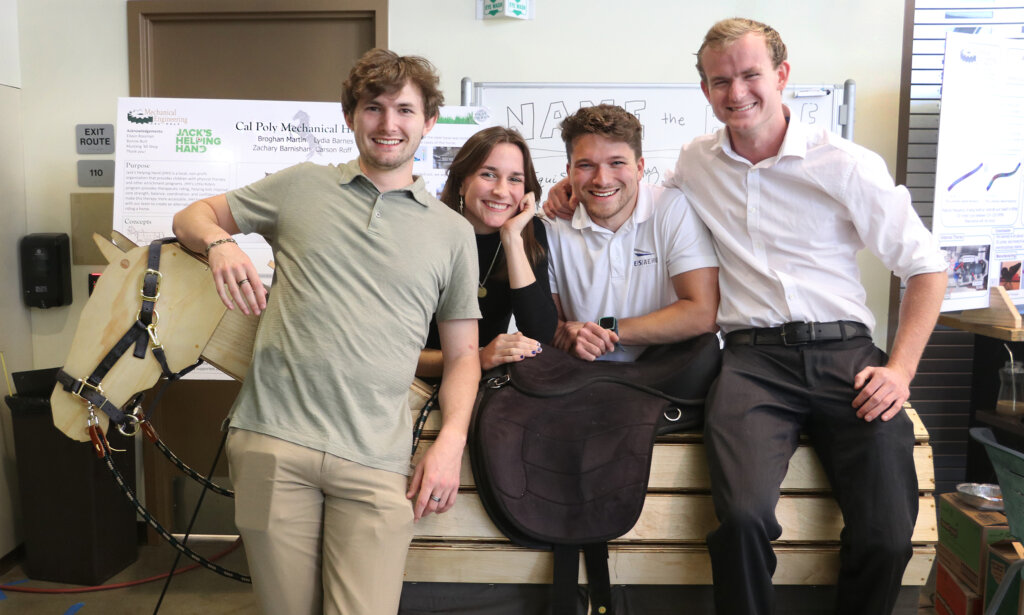Learn by Doing was on display in a big way during the College of Engineering Project Expo when seniors presented prototypes designed to aid wildland firefighters, makeup artists, Parkinson’s disease patients and children with disabilities.
More than 150 projects filled Engineering Plaza buildings and outdoor spaces on June 2 as sponsors, faculty members and families actively engaged with the teams about their yearlong endeavors.
“The Cal Poly Engineering Project Expo is the best day of our academic year,” Dean Amy Fleischer said. “The projects that our students complete are uniformly impressive and serve as a testament to their creativity, dedication and ingenuity.”
Forty-five mechanical engineering teams were positioned in and around the Bonderson Projects Center, offering visitors the chance to interact with their prototypes from a weed zip tie installer to a mechanical horse.
The horse was constructed for Jack’s Helping Hand – a nonprofit group that aids local children with cancer or special needs – after Little Riders program organizers requested an alternative way for children with physical or cognitive disabilities to experience riding in preparation for equine therapy.
Mechanical engineering students Broghan Martin, Zachary Barnishan, Lydia Barnes and Carson Roff accepted the challenge, designing a horse with a wooden body, springs and steel frame base they invited expo visitors to test out.
“This is a steppingstone so children can develop confidence riding a horse,” said Barnes, explaining the horse stops when the rider does. “I love to work with kids, and building it was so fun.”
Right after the expo, the team delivered the horse to excited children at Jack’s Helping Hand ranch.
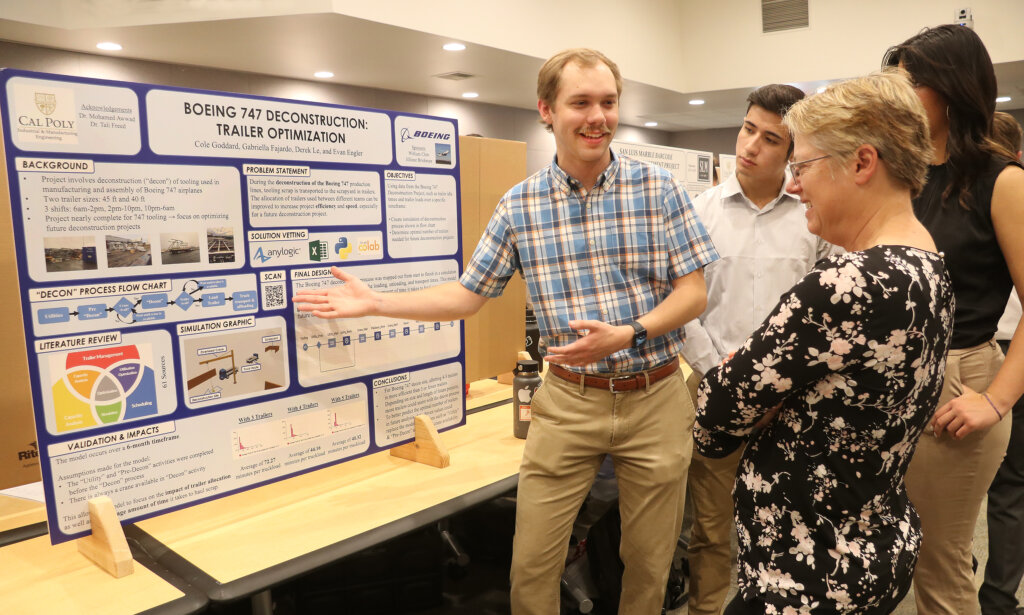
Another project that sparked interest was a height-adjustable portable makeup chair constructed by Christina Totorica, Cristian Garcia, Edgar Sanchez and Erik Mote.
The mechanical engineering team crafted the chair with hollow aluminum tubes and 3D printed components after a local makeup artist requested a seat she could transport in her car and adjust to the height of her clients.
The project gave the team experience with tools they hadn’t used before, according to Totorica, who was eager to show the creation to their sponsor.
Nearby, the mechanical engineering team of Tommy Link, Kyle McAfee, Marc Monier and Hunter Walden displayed their bespoke bicycle enclosure designed for a military veteran from New York with vision impairment who relies on his bicycle for transportation.
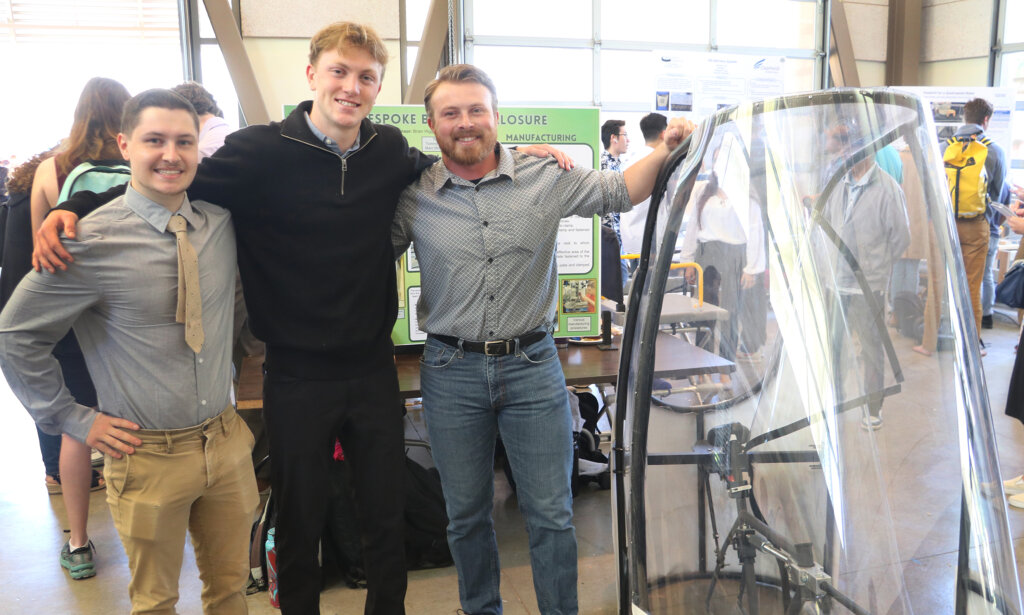
The veteran is aided by ultrasonic sensors on his bike that alert him to obstacles via sound and vibration. He is prevented from riding in inclement weather since the sensors must remain dry, so he enlisted help with an enclosure.
“There isn’t something out there on this scale and we definitely learned lessons,” said Walden, noting their device provides an adequate shield but is too heavy to mount on a road racing bicycle due to the materials used.
Seventeen biomedical engineering teams packed the Advanced Technology Laboratories, or ATL, with innovations including perhaps the best-named project: the Disc-Go Rollator.
Jack Hauser, Anthony Kwon, Garrett Ridder and Ashley Vu designed the device that attaches to a rolling walker and projects colored discs on the ground, giving people with Parkinson’s gait visual cues to help them measure the length of their steps.
Next to the Disc-Go Rollator, the team of Noor Mahmoud, McKinna Lee and Analyssa Torres presented their dysmenorrhea relief device – a compression sock integrated with a blood pressure cuff to activate pressure points on the foot to alleviate period pain.
The unique collaboration involved Da Vinci High School students who proposed a problem – in this case, menstrual cramps – and Cal Poly students who offered a solution.
“We turned to Eastern medicine because we wanted a more discreet, noninvasive device as an alternative to carrying around a heating pad or relying on drugs,” said Lee, adding testing can occur after approval from the Institutional Review Board, or IRB.
The Da Vinci students received project updates over Zoom as they watched engineering in action.
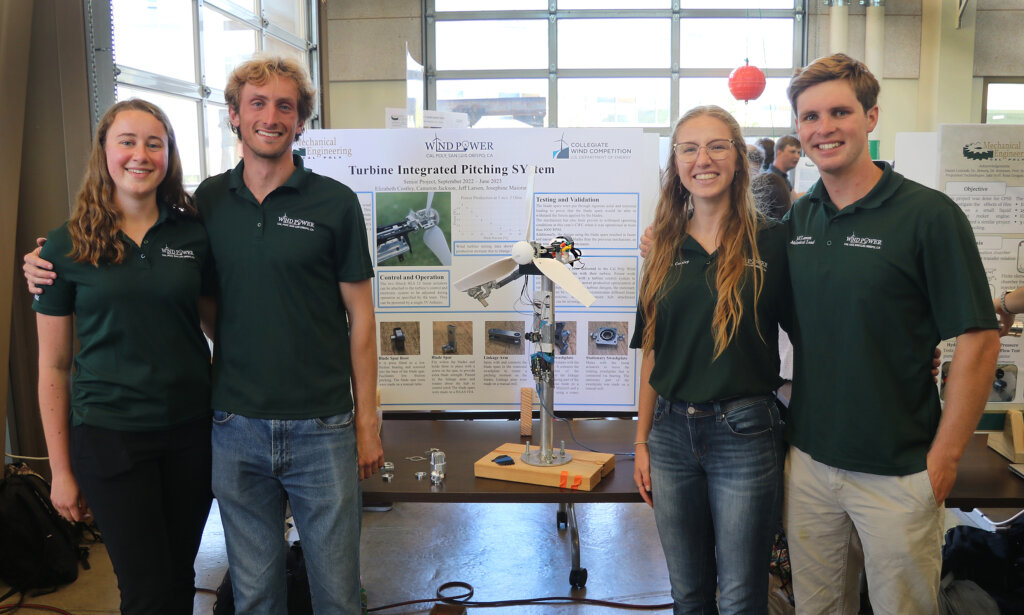
Another sponsor – the Wildfire Conservancy – asked seniors to invent a better respirator for wildland firefighters that offers breathing protection without impairing visibility or interfering with communication.
Two teams – one mechanical and one interdisciplinary – created devices for the conservancy.
Outside the ATL, the interdisciplinary team of Nissi Velasquez (mechanical), Bradie Strauch (biomedical), Calvin Chou (electrical) and Miles Larson (industrial) gave demonstrations of their tubing system that attaches to a fire helmet and releases filtered air through small holes, forming a shield of air around the face.
“With structure fires, firefighters take in big air tanks and masks, but traditionally wildland firefighters have only used bandanas or a simple mask,” Chou explained. “Our device offers better protection without restrictions.”
Work on the respirator devices will continue next year with funding from the conservancy.
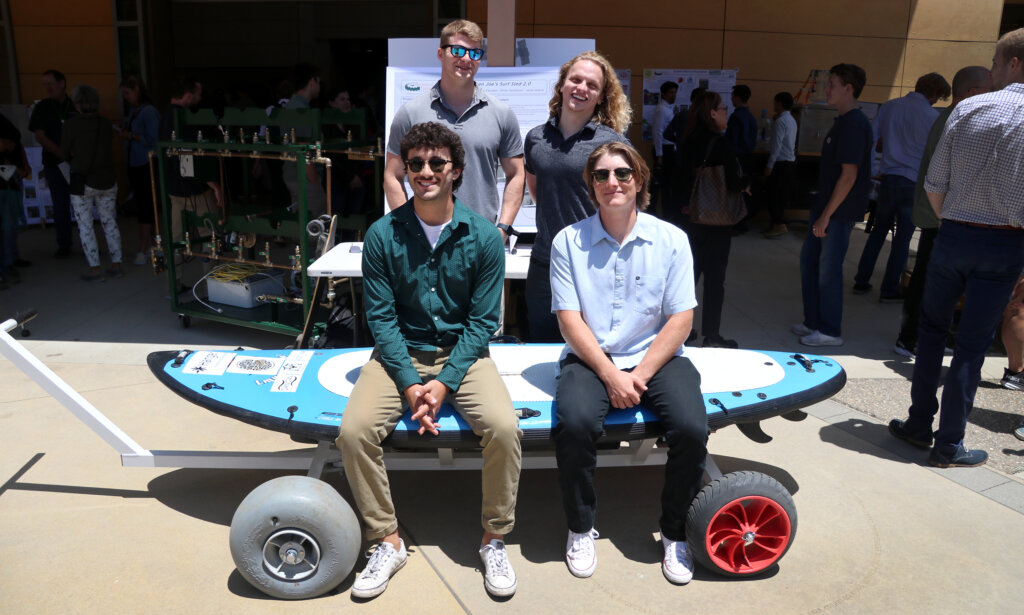
Sixteen interdisciplinary projects were featured at the expo, including crowd favorite Spikeless – a test strip wristband that helps young socializers ensure their drinks are drug-free.
Jensen Jalufka (business), Logan Hughes (business), Jano Muri (mechanical engineering), Elisa Horta (mechanical engineering) and Justice Radler (industrial engineering) developed the idea of a printable wristband with reagents that change color upon detecting the drug GHB.
The team won third place and $5,000 at Innovation Quest 2023 – a student startup competition organized by the Cal Poly Center for Innovation and Entrepreneurship.
“People could wear them to a festival, bar scene or any number of places,” said Jalufka who is staying at Cal Poly for graduate school and hopes to enlist chemistry students to conduct further testing. “We took Spikeless out to Dexter Lawn and so many people were interested!”
Other engineering departments with expo projects included civil and environmental with eight; computer engineering with six; industrial and manufacturing with 17; materials with 23; computer science and software with nine; and electrical with 20.
By Emily Slater


